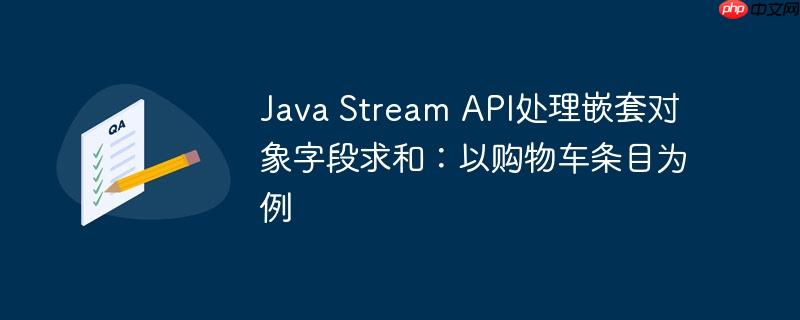
本文深入探讨如何利用Java Stream API高效地对复杂嵌套对象中的数值字段进行聚合求和。通过一个购物车条目的具体案例,演示了如何从多层级对象中提取并累加BigDecimal类型的费用数据,强调了mapTodouble、BigDecimal的精确计算以及在处理可能为空的字段时,结合注解进行NULL值判断的关键注意事项。
在现代java应用开发中,数据模型往往涉及多层嵌套的对象结构。当我们需要从这些深层结构中提取特定数值并进行聚合计算时,如何高效且优雅地实现是一个常见挑战。本教程将以一个典型的电商购物车场景为例,展示如何使用java stream api来解决这一问题。
问题场景:聚合嵌套费用数据
假设我们有以下一系列Java类,它们共同构成了购物车中的一个条目及其相关的费用信息:
- CartEntry:购物车条目,包含一个Fulfillment对象,并计划存储totalDeliveryFee。
- Fulfillment:配送信息,包含一个Storedelivery对象。
- StoreDelivery:门店配送详情,包含cost(成本)和deliveryServiceFee(配送服务费),以及一个Deliverywindow对象。
- DeliveryWindow:配送窗口,包含一个fee(窗口费)。
我们的目标是从一个CartEntry列表中,将每个CartEntry中嵌套的cost、deliveryServiceFee和fee这三个BigDecimal类型的字段值累加起来,形成一个总的配送费用。
传统迭代与Stream API的对比
如果采用传统的循环迭代方式,我们需要编写多层嵌套的if判断和for循环来逐层访问对象并累加,代码会显得冗长且易出错。Java 8引入的Stream API为这种场景提供了更简洁、更具表达力的解决方案。
采用Stream API进行高效求和
解决此问题的核心在于利用Stream API的mapToDouble操作,结合BigDecimal的精确计算能力。以下是实现这一目标的推荐方法:
立即学习“Java免费学习笔记(深入)”;
import java.math.BigDecimal; import java.util.List; import java.util.Optional; // 假设的类结构,与问题描述一致 class CartEntry { private Fulfillment fulfillment; private BigDecimal totalDeliveryFee = BigDecimal.ZERO; // 初始化为0 public CartEntry(Fulfillment fulfillment) { this.fulfillment = fulfillment; } public Fulfillment getFulfillment() { return fulfillment; } public BigDecimal getTotalDeliveryFee() { return totalDeliveryFee; } public void setTotalDeliveryFee(BigDecimal totalDeliveryFee) { this.totalDeliveryFee = totalDeliveryFee; } } class Fulfillment { private StoreDelivery storeDelivery; public Fulfillment(StoreDelivery storeDelivery) { this.storeDelivery = storeDelivery; } public StoreDelivery getStoreDelivery() { return storeDelivery; } } class StoreDelivery { private BigDecimal cost = BigDecimal.ZERO; private BigDecimal deliveryServiceFee = BigDecimal.ZERO; private DeliveryWindow deliveryWindow; public StoreDelivery(BigDecimal cost, BigDecimal deliveryServiceFee, DeliveryWindow deliveryWindow) { this.cost = cost; this.deliveryServiceFee = deliveryServiceFee; this.deliveryWindow = deliveryWindow; } public BigDecimal getCost() { return cost; } public BigDecimal getDeliveryServiceFee() { return deliveryServiceFee; } public DeliveryWindow getDeliveryWindow() { return deliveryWindow; } } class DeliveryWindow { private BigDecimal fee = BigDecimal.ZERO; public DeliveryWindow(BigDecimal fee) { this.fee = fee; } public BigDecimal getFee() { return fee; } } public class CartEntryTotalDeliveryFeeCalculator { public static double calculateTotalDeliveryFee(List<CartEntry> entries) { if (entries == null || entries.isEmpty()) { return 0.0; } return entries.stream() .mapToDouble(entry -> { // 初始化当前条目的总费用 BigDecimal currentEntryTotal = BigDecimal.ZERO; // 尝试获取CartEntry自身的totalDeliveryFee(如果已有值) currentEntryTotal = currentEntryTotal.add( Optional.ofNullable(entry.getTotalDeliveryFee()).orElse(BigDecimal.ZERO) ); // 尝试获取Fulfillment -> StoreDelivery -> cost currentEntryTotal = currentEntryTotal.add( Optional.ofNullable(entry.getFulfillment()) .map(Fulfillment::getStoreDelivery) .map(StoreDelivery::getCost) .orElse(BigDecimal.ZERO) ); // 尝试获取Fulfillment -> StoreDelivery -> deliveryServiceFee currentEntryTotal = currentEntryTotal.add( Optional.ofNullable(entry.getFulfillment()) .map(Fulfillment::getStoreDelivery) .map(StoreDelivery::getDeliveryServiceFee) .orElse(BigDecimal.ZERO) ); // 尝试获取Fulfillment -> StoreDelivery -> DeliveryWindow -> fee currentEntryTotal = currentEntryTotal.add( Optional.ofNullable(entry.getFulfillment()) .map(Fulfillment::getStoreDelivery) .map(StoreDelivery::getDeliveryWindow) .map(DeliveryWindow::getFee) .orElse(BigDecimal.ZERO) ); return currentEntryTotal.doubleValue(); }) .sum(); } public static void main(String[] args) { // 示例数据 DeliveryWindow dw1 = new DeliveryWindow(new BigDecimal("5.00")); StoreDelivery sd1 = new StoreDelivery(new BigDecimal("10.50"), new BigDecimal("2.25"), dw1); Fulfillment f1 = new Fulfillment(sd1); CartEntry ce1 = new CartEntry(f1); ce1.setTotalDeliveryFee(new BigDecimal("1.00")); // 假设CartEntry自身可能也有一个初始费用 DeliveryWindow dw2 = new DeliveryWindow(new BigDecimal("3.00")); StoreDelivery sd2 = new StoreDelivery(new BigDecimal("7.00"), new BigDecimal("1.50"), dw2); Fulfillment f2 = new Fulfillment(sd2); CartEntry ce2 = new CartEntry(f2); // 包含null值的场景 CartEntry ce3 = new CartEntry(null); // 没有Fulfillment CartEntry ce4 = new CartEntry(new Fulfillment(null)); // 没有StoreDelivery CartEntry ce5 = new CartEntry(new Fulfillment(new StoreDelivery(new BigDecimal("2.00"), null, null))); // 部分字段为null List<CartEntry> entries = List.of(ce1, ce2, ce3, ce4, ce5); double total = calculateTotalDeliveryFee(entries); System.out.println("所有购物车条目的总配送费用: " + total); // 期望值: (1.00 + 10.50 + 2.25 + 5.00) + (0 + 7.00 + 1.50 + 3.00) + (0) + (0) + (2.00) = 32.25 } }
代码解析
- entries.stream(): 创建一个CartEntry对象的流。
- mapToDouble(entry -> { … }): 这是核心部分。对于流中的每个CartEntry对象,我们执行一个映射操作,将其转换为一个double值。
- 在映射函数内部,我们初始化一个BigDecimal变量currentEntryTotal来累积当前CartEntry的所有相关费用。
- 链式访问与Optional处理: 为了安全地访问深层嵌套的对象字段并避免NullPointerException,我们使用了Optional.ofNullable()。
- Optional.ofNullable(entry.getFulfillment()):如果fulfillment不为null,则返回一个包含它的Optional;否则返回Optional.empty()。
- .map(Fulfillment::getStoreDelivery):如果上一步的Optional有值,则继续映射到StoreDelivery对象。
- .map(StoreDelivery::getCost):继续映射到cost字段。
- .orElse(BigDecimal.ZERO):如果任何一步的映射导致Optional为空(即某个中间对象或最终字段为null),则返回BigDecimal.ZERO作为替代值,确保求和操作不会中断。
- currentEntryTotal.add(…): 将通过Optional安全获取的BigDecimal值累加到currentEntryTotal中。
- .doubleValue(): 在返回前,将最终的BigDecimal总和转换为double类型,以供mapToDouble使用。
- .sum(): 对mapToDouble生成的所有double值进行最终求和,得到所有购物车条目的总配送费用。
注意事项
-
BigDecimal的精度: 在处理货币或任何需要精确计算的数值时,始终优先使用BigDecimal而非double或Float。doubleValue()方法在最终求和前将BigDecimal转换为double,如果对最终结果的精度有极高要求,可以考虑使用Stream<BigDecimal>并配合reduce操作来保持BigDecimal的精度,但这样会稍微复杂一些。
// 保持BigDecimal精度的求和示例 BigDecimal totalBigDecimal = entries.stream() .map(entry -> { BigDecimal currentEntryTotal = BigDecimal.ZERO; // ... (同上,通过Optional获取并add所有BigDecimal字段) return currentEntryTotal; }) .reduce(BigDecimal.ZERO, BigDecimal::add); System.out.println("所有购物车条目的总配送费用 (BigDecimal): " + totalBigDecimal); -
Null值处理与注解:
- 在原始问题中,类字段使用了@NotNull和@DecimalMin(“0.0”)等注解。这些注解通常在编译时或运行时由验证框架(如JSR 303/380 Bean Validation)进行检查,以确保字段不为null且满足最小值。
- 如果这些注解能保证在业务逻辑执行到此处时,所有BigDecimal字段(如cost, deliveryServiceFee, fee)及其父对象都不会是null,并且BigDecimal类型的字段在未显式赋值时会自动初始化为BigDecimal.ZERO,那么上述代码中的Optional.ofNullable().orElse(BigDecimal.ZERO)部分可以简化,直接通过getter方法访问。
- 然而,如果这些保证不完全可靠(例如,对象可能在不经过完整验证流程的情况下被创建或修改),或者中间对象(如fulfillment或storeDelivery)可能为null,那么使用Optional进行防御性编程仍然是最佳实践,以增强代码的健壮性。本教程中的示例代码已包含这种防御性处理。
-
代码可读性: 当嵌套层级过多时,map操作内部的逻辑可能会变得复杂。可以考虑将获取单个CartEntry总费用的逻辑封装到一个私有辅助方法中,以提高可读性。
总结
通过Java Stream API,我们可以以声明式的方式优雅地处理复杂嵌套对象中的数据聚合任务。结合mapToDouble和BigDecimal的精确计算,以及Optional的防御性编程,能够编写出既高效又健壮的代码。在实际开发中,理解数据模型的约束(如注解带来的null值保证)将有助于我们选择最简洁有效的实现方式。


评论(已关闭)
评论已关闭